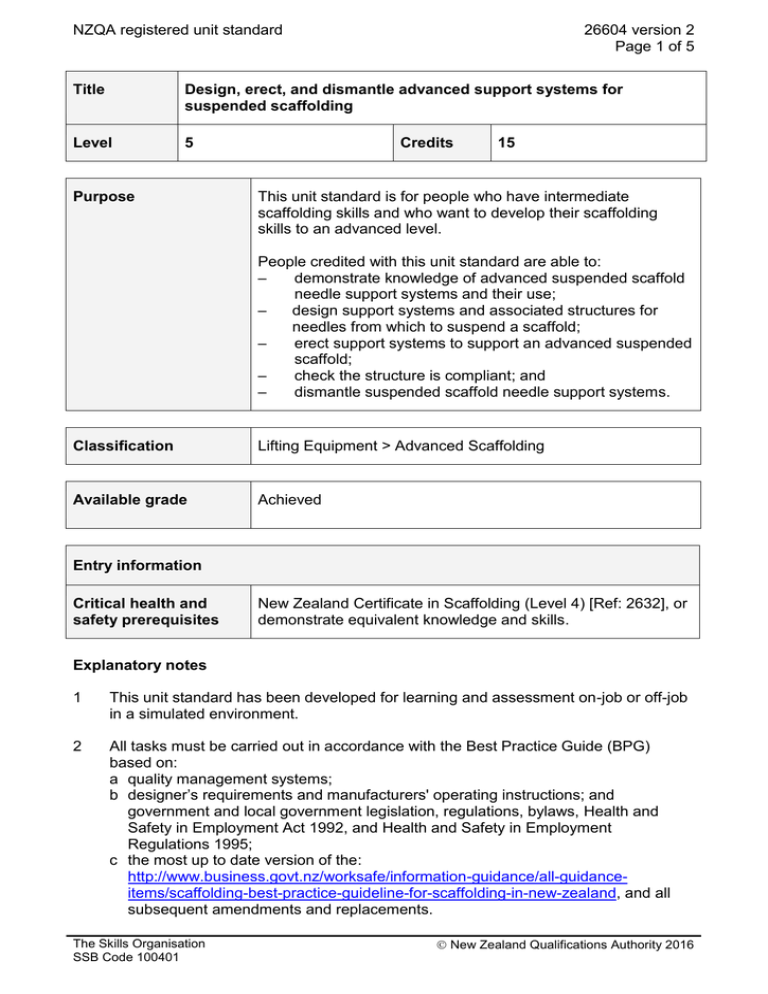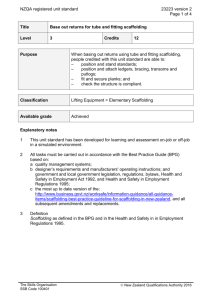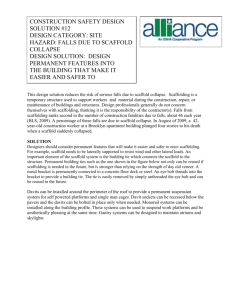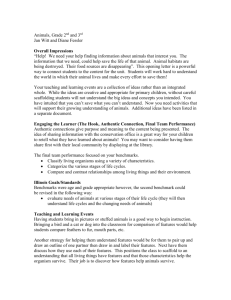NZQA registered unit standard 26604 version 2 Page 1 of 5
advertisement

NZQA registered unit standard 26604 version 2 Page 1 of 5 Title Design, erect, and dismantle advanced support systems for suspended scaffolding Level 5 Purpose Credits 15 This unit standard is for people who have intermediate scaffolding skills and who want to develop their scaffolding skills to an advanced level. People credited with this unit standard are able to: – demonstrate knowledge of advanced suspended scaffold needle support systems and their use; – design support systems and associated structures for needles from which to suspend a scaffold; – erect support systems to support an advanced suspended scaffold; – check the structure is compliant; and – dismantle suspended scaffold needle support systems. Classification Lifting Equipment > Advanced Scaffolding Available grade Achieved Entry information Critical health and safety prerequisites New Zealand Certificate in Scaffolding (Level 4) [Ref: 2632], or demonstrate equivalent knowledge and skills. Explanatory notes 1 This unit standard has been developed for learning and assessment on-job or off-job in a simulated environment. 2 All tasks must be carried out in accordance with the Best Practice Guide (BPG) based on: a quality management systems; b designer’s requirements and manufacturers' operating instructions; and government and local government legislation, regulations, bylaws, Health and Safety in Employment Act 1992, and Health and Safety in Employment Regulations 1995; c the most up to date version of the: http://www.business.govt.nz/worksafe/information-guidance/all-guidanceitems/scaffolding-best-practice-guideline-for-scaffolding-in-new-zealand, and all subsequent amendments and replacements. The Skills Organisation SSB Code 100401 New Zealand Qualifications Authority 2016 NZQA registered unit standard 26604 version 2 Page 2 of 5 3 Definitions Client: an individual or representative of a company who commissions a particular scaffold or scaffolding structure to be erected, or is an end user of the scaffold or scaffolding structure. Restored or repaired: the steps taken to ensure the end state of the supporting structure in accordance with site requirements; Support system: the scaffolding (mobile or static), bracing, and ties used to hold in place and stabilise needles from which a scaffold is suspended. This system, and/or the needles themselves, are normally connected to the building or structure from or on which the suspended scaffold is erected. This is referred to as the ‘supporting structure’; Suspended scaffold: capable of being raised or lowered. A working platform that cannot be raised or lowered is classified as a hanging scaffold, not a suspended scaffold; Scaffold plan: a key design document prepared by the candidate and used as a basis for the erection of a particular scaffold; Scaffolding as defined in the BPG and in the Health and Safety in in Employment Regulations 1995. 4 Assessment During assessment against this unit standard, the design, erection, and dismantling of scaffolds, suspended scaffolds, and scaffolding structures and components must take place under the supervision of a certified scaffolder who holds a current Certificate of Competence for the scaffolding concerned. 5 Evidence is required for at least three suspended scaffolding support systems. These are non-proprietary systems that require the construction of scaffolds for support of the needles and suspended structure. They should, however, include mixed proprietary scaffolding components and tube and fitting components. Tube and fitting components must therefore be included in each of the three suspended scaffolding support systems. Outcomes and evidence requirements Outcome 1 Demonstrate knowledge of advanced suspended scaffold needle support systems and their use. Evidence requirements 1.1 Identify needle support systems and describe suspended scaffolding situations in which they might be used in terms of their advantages and disadvantages. Range The Skills Organisation SSB Code 100401 may include but is not limited to – multi-directional support, access, need for additional bracing, point of attachment security, number of components, ability to vary the length, need for lateral bracing, strength of fixing components; two advantages and two disadvantages for each of two situations per system. New Zealand Qualifications Authority 2016 NZQA registered unit standard 1.2 Identify equipment associated with the use of needles in situations where they might be used, and describe its function in suspended scaffolding. Range 1.3 26604 version 2 Page 3 of 5 may include but is not limited to – wire and shackle restraints, counterweights, bolted supports, bracing, construction of standard and non-standard scaffolding structures to support needles and suspended elements. Recommend needle bracing options for situations where they might be used. Range may include but are not limited to – transverse bracing, wire and brace tie-backs, bolted supports, construction of standard and non-standard scaffolding structures for support. Outcome 2 Design support systems and associated structures for needles from which to suspend a scaffold. Evidence requirements 2.1 Confirm suspended scaffolding requirements with the supervisor, client, or chartered engineer. Range 2.2 Check the supporting structure for its capacity to support the suspended scaffold and associated support system and scaffolding components. Range 2.3 includes but is not limited to – establishing maximum load, placement in relation to support structures and mechanisms, needle type/s, attachment points, access and space for counterweighting and additional scaffolding for support. includes but is not limited to – confirmation of structural integrity, access points, the presence of and need for additional scaffolding structures for support, identification of attachment, tie and bracing points. Determine design parameters including, where necessary, meeting chartered engineer’s requirements. Range The Skills Organisation SSB Code 100401 includes but is not limited to – placement and nature of needles, supports, propping, counterweights and ties; the nature of supports for, and placement of, bracing and ties for supporting scaffold components; loading calculations; access; direction and magnitude of forces; regulatory requirements; safety margins. New Zealand Qualifications Authority 2016 NZQA registered unit standard 2.4 Prepare design documents including, where necessary, incorporating advice from a chartered engineer. Range 2.5 26604 version 2 Page 4 of 5 includes – scaffold plan, gear list, and, where applicable, engineer’s requirements; may include but is not limited to – CAD printouts, work schedules, staffing allocation, WorkSafe New Zealand and local authority approvals, workplace-specific documentation. Check where necessary, the scaffold plan and associated design documents by a chartered engineer and make adjustments as required. Outcome 3 Erect support systems to support an advanced suspended scaffold. Evidence requirements 3.1 Recheck safety factors in accordance with the scaffold plan. Range includes but is not limited to – attachment points, placement of needles, propping, counterweights, bracing and tie points and their structure for needles and any supporting scaffolding, load weights, bracing methods, direction and magnitude of forces. 3.2 Source the necessary equipment in accordance with the scaffold plan. 3.3 Position, secure, tie and brace needles and other suspended scaffold members in accordance with the scaffold plan. 3.4 Erect and brace subsequent components and scaffolding support structures in accordance with the scaffold plan. Outcome 4 Check the structure is compliant. Evidence requirements 4.1 Check the structure for compliance in accordance with the scaffold plan. 4.2 Complete a BPG inspection report. 4.3 Make changes to the structure to it to ensure compliance and amend the BPG inspection report accordingly. 4.4 Arrange for the structure, where necessary, to be inspected by a certificated scaffolder who has an appropriate certificate of competency, or by a chartered engineer. Make changes to the structure to ensure compliance. The Skills Organisation SSB Code 100401 New Zealand Qualifications Authority 2016 NZQA registered unit standard 26604 version 2 Page 5 of 5 Outcome 5 Dismantle advanced suspended scaffold needle support systems. Evidence requirements 5.1 Raise and secure suspended components and remove needles and associated support systems. 5.2 Detach needles and associated support systems from the supporting structure. 5.3 Lower components to the ground and prepare for transportation off-site. 5.4 Restore and repair attachment points in accordance with site requirements. Planned review date 31 December 2019 Status information and last date for assessment for superseded versions Process Version Date Last Date for Assessment Registration 1 21 July 2011 31 December 2016 Review 2 16 July 2015 N/A Consent and Moderation Requirements (CMR) reference 0183 This CMR can be accessed at http://www.nzqa.govt.nz/framework/search/index.do. Please note Providers must be granted consent to assess against standards (accredited) by NZQA, before they can report credits from assessment against unit standards or deliver courses of study leading to that assessment. Industry Training Organisations must be granted consent to assess against standards by NZQA before they can register credits from assessment against unit standards. Providers and Industry Training Organisations, which have been granted consent and which are assessing against unit standards must engage with the moderation system that applies to those standards. Requirements for consent to assess and an outline of the moderation system that applies to this standard are outlined in the Consent and Moderation Requirements (CMRs). The CMR also includes useful information about special requirements for organisations wishing to develop education and training programmes, such as minimum qualifications for tutors and assessors, and special resource requirements. Comments on this unit standard Please contact The Skills Organisation at reviewcomments@skills.org.nz if you wish to suggest changes to the content of this unit standard. The Skills Organisation SSB Code 100401 New Zealand Qualifications Authority 2016



